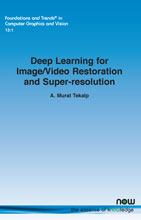Deep Learning for Image/Video Restoration and Super-resolution
By A. Murat Tekalp, Department of Electrical and Electronics Engineering, Koç University, Turkey, mtekalp@ku.edu.tr
Abstract
Recent advances in neural signal processing led to significant improvements in the performance of learned image/video restoration and super-resolution (SR). An important benefit of data-driven deep learning approaches to image processing is that neural models can be optimized for any differentiable loss function, including perceptual loss functions, leading to perceptual image/video restoration and SR, which cannot be easily handled by traditional model-based methods.
We start with a brief problem statement and a short discussion on traditional vs. data-driven solutions. We next review recent advances in neural architectures, such as residual blocks, dense connections, residual-in-residual dense blocks, residual blocks with generative neurons, self-attention and visual transformers. We then discuss loss functions and evaluation (assessment) criteria for image/video restoration and SR, including fidelity (distortion) and perceptual criteria, and the relation between them, where we briefly review the perception vs. distortion trade-off.
We can consider learned image/video restoration and SR as learning either a nonlinear regressive mapping from degraded to ideal images based on the universal approximation theorem, or a generative model that captures the probability distribution of ideal images. We first review regressive inference via residual and/or dense convolutional networks (ConvNet). We also show that using a new architecture with residual blocks based on a generative neuron model can outperform classical residual ConvNets in peak-signal-to-noise ratio (PSNR). We next discuss generative inference based on adversarial training, such as SRGAN and ESRGAN, which can reproduce realistic textures, or based on normalizing flow such as SRFlow by optimizing log-likelihood. We then discuss problems in applying supervised training to real-life restoration and SR, including overfitting image priors and overfitting the degradation model seen in the training set. We introduce multiple-model SR and real-world SR (from unpaired training data) formulations to overcome these problems. Integration of traditional model-based methods and deep learning for non-blind restoration/SR is introduced as another solution to model overfitting in supervised learning.
In learned video restoration and SR (VSR), we first discuss how to best exploit temporal correlations in video, including sliding temporal window vs. recurrent architectures for propagation, and aligning frames in the pixel domain using optical flow vs. in the feature space using deformable convolutions. We next introduce early fusion with feature-space alignment, employed by the EDVR network, which obtains excellent PSNR performance. However, it is well-known that videos with the highest PSNR may not be the most appealing to humans, since minimizing the mean-square error may result in blurring of details. We then address perceptual optimization of VSR models to obtain natural texture and motion. Although perception-distortion tradeoff has been well studied for images, few works address perceptual VSR. In addition to using perceptual losses, such as MS-SSIM, LPIPS, and/or adversarial training, we also discuss explicit loss functions/criteria to enforce and evaluate temporal consistency. We conclude with a discussion of open problems.
Deep Learning for Image/Video Restoration and Super-resolution
In this monograph, an overview of recent developments and the state-of-the-art in image/video restoration and super-resolution (SR) using deep learning is presented. Deep learning has made a significant impact, not only on computer vision and natural language processing but also on classical signal processing problems such as image/video restoration/SR and compression. Recent advances in neural architectures led to significant improvements in the performance of learned image/video restoration and SR. An important benefit of data-driven deep learning approaches is that neural models can be optimized for any differentiable loss function, including visual perceptual loss functions, leading to perceptual video restoration and SR, which cannot be easily handled by traditional model-based approaches.
The publication starts with a problem statement and a short discussion on traditional vs. data-driven solutions. Thereafter, recent advances in neural architectures are considered, and the loss functions and evaluation criteria for image/video restoration and SR are discussed. Also considered are the learned image restoration and SR, as learning either a mapping from the space of degraded images to ideal images based on the universal approximation theorem, or a generative model that captures the probability distribution of ideal images. Practical problems in applying supervised training to real-life restoration and SR are also included, as well as the solution models.
In the section on learned video SR, approaches to exploit temporal correlations in learned video processing are covered, and then the perceptual optimization of the network parameters to obtain natural texture and motion is discussed. A comparative discussion of various approaches concludes the publication.
